Jill Konrath's Blog, page 21
April 3, 2014
One Easy Tip for a Successful Sales Conversation
You've probably heard that being a good listener is the key to being successful in sales. While I agree that it's essential, I'm here to tell you that your ability to ask good sales questions is even more important.
Why is that? Let me give you a little bit of scientific fact. Your brain is unable to do two things simultaneously. It can either listen OR it can formulate questions to ask. Not both. Just one. So if you're just listening, that's nice and clearly your prospect is being heard.
But if you're not asking the right questions, all you're going to get is gobbledygook. Meaningless drivel that builds relationships, but doesn't advance the sales process.
The ONLY way that you're going to have a valuable sales conversation - for both you and your prospect - is to plan your questions ahead of time.
Think about what you can ask that gets your prospect talking about their situation, their issues and yes, their challenges.
Think about questions that might actually provoke your customer – making them think about things they haven't thought of before. Figure out what you need to ask to determine if making a change makes good sense for your prospect.
Write everything down. Then, when you actually do meet, you can say, "In preparation for today's meeting, I wrote down a few questions." Now, you can relax and really listen.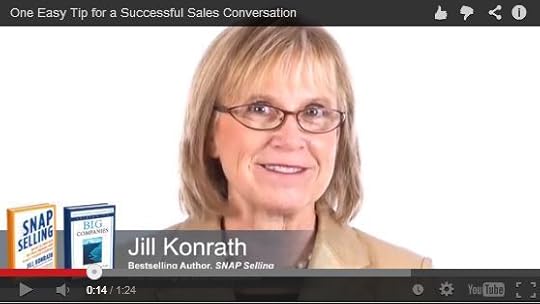






March 29, 2014
Achieving Outrageous Success
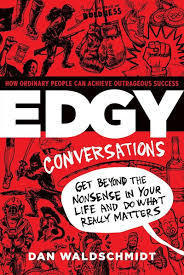 Every once in a while, someone jolts me out of my comfort zone - and makes me question what I'm doing. Dan Waldschmidt, author of the new book EDGY Conversations, is one person who always seems to do that. He's spent the past four years studying how ordinary people were achieving success against all odds. I hope you enjoy my interview with him.
Every once in a while, someone jolts me out of my comfort zone - and makes me question what I'm doing. Dan Waldschmidt, author of the new book EDGY Conversations, is one person who always seems to do that. He's spent the past four years studying how ordinary people were achieving success against all odds. I hope you enjoy my interview with him.
JILL: Dan, EDGY is an acronym that stands for the four behaviors that high performers use to produce outrageous results. Tell us about them.
Dan Waldschmidt: Sure. After studying 1000 high performers, we saw that they were Extreme in their beliefs and behaviors. They demonstrate a maniacal focus and Discipline for getting things done.
They are Givers - intentionally and almost automatically. And they understand the (Y)Human side of life - instead of just expecting everyone else around them to be logical, they understand how pain, fear, and failure impact those around them.
While each high performer we looked at had clear, distinctive ways that they excelled above their peers, they all share these four qualities. All of them were extreme, disciplined, giving, and human.
JILL: Why talk about attitudes and philosophies instead of a series of “steps” that people can follow? Aren’t “steps” more practical?
Dan Waldschmidt: The right attitudes create outcomes that are unpredictably magical. By changing your attitude, you free yourself to explore ideas that otherwise would have just been unthinkable.
The “right” actions will always change, but developing the right attitudes have a timeless impact. That's why we focus on helping readers achieve better attitudes.
JILL: What are a few practical lessons you learned from your research in writing the book?
Dan Waldschmidt: High performers ignore a great deal of advice. Some comes from people they love. Other advice is criticism from people who “know better” and are happy to tell them that what they’re doing “isn't going to work”.
High performers don't spend time reasoning with doubters, they just continue moving forward towards where they want to be.
High-performers believe that achieving audacious dreams is rooted in hard work. They're relentless about putting in the sweat equity that their dreams deserve.
JILL: What is one thing that an ordinary person trying to achieve to outrageous success should start doing right now?
Dan Waldschmidt: EDGY is a mindset change. An attitude change is the single most important thing someone can do right now. If there is one thing that you can do to change your life for the better it begins with brutal honesty about who you really are. Not what you are doing or what have you done in the past. Who are you? What are your motivations?
Lying to yourself is a dangerous trap. It’s the biggest reason why ordinary people stay ordinary. They spend time making excuses and pretending like they are doing everything right instead of improving.
JILL: How does this apply in a business setting?
Dan Waldschmidt: The word “edgy” might seem out of place in a business setting, but the principles are applicable, none the less. Standout companies have radical beliefs. Great leaders demand accountability. They measure progress and change course in order to drive better results. Growing, vibrant companies give more value than people pay them to give. They don't trade long-term growth for short-term tricks and manipulation.
Being a little bit more “human” is a life skill that will make you an infinitely better business person. Compassion, insight, and thoughtfulness are endearing and attractive qualities to everyone you encounter. EDGY has a big place in the enterprise. The principles are timeless.
JILL: Thanks so much, Dan. You're kicking our butts! And readers, click here to get your copy of EDGY Conversations. It's filled with great stories that will inspire you to achieve more than you thought possible.
About Dan Waldschmidt
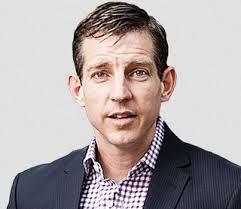 Dan Waldschmidt is an international business strategist, speaker, author, and extreme athlete. His consulting firm solves complex marketing and business strategy problems for savvy companies all over the world. Dow Jones calls his Edgy Conversations blog one of the top sales sites on the Internet.
Dan Waldschmidt is an international business strategist, speaker, author, and extreme athlete. His consulting firm solves complex marketing and business strategy problems for savvy companies all over the world. Dow Jones calls his Edgy Conversations blog one of the top sales sites on the Internet.
He’s been profiled in Business Week, INC Magazine, BBC, Fox News, The Today Show, and Business Insider, has been the featured guest on dozens of radio programs, and has published hundreds of articles on progressive business strategy. He is author of Edgy Conversations: How Ordinary People Achieve Outrageous Success.






March 25, 2014
How to Quickly Position Yourself as a Trusted Advisor
How can you quickly position yourself as a trusted advisor when meeting someone new?
Here are 3 strategies you can use to immediately be seen as a credible, potentially invaluable resource:
Mention similar businesses you've worked with, making sure to highlight the results they've achieved from their relationship with your company.
Ask insightful questions about their business direction. This shows you've done your homework and are focused on helping them, not making the sale.
Have a genuine conversation. I mean it. Stop selling. Trusted advisors don't hype their credentials, pitch their products & services, or close. They focus on making a difference for their prospects. And, they're willing to walk away from a potential opportunity if they're not the right fit.
Your long-term success as a seller depends on your ability to implement these strategies.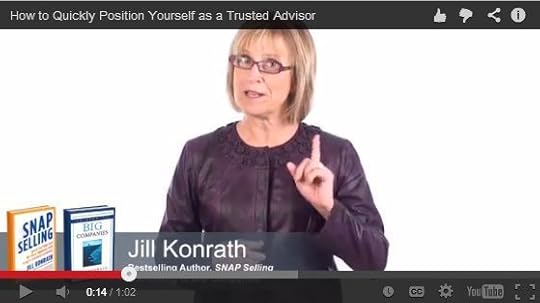






March 23, 2014
How to Hire & Onboard Salespeople - The Right Way!
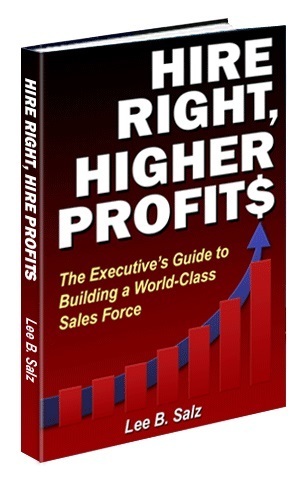 Thinking about hiring any new salespeople in the not-too-distant future? Or are you still suffering from a bad hire? If so, check out my interview with Lee Salz, onboarding expert and author of Hire Right, Higher Profits. I know you'll get some good ideas.
Thinking about hiring any new salespeople in the not-too-distant future? Or are you still suffering from a bad hire? If so, check out my interview with Lee Salz, onboarding expert and author of Hire Right, Higher Profits. I know you'll get some good ideas.
(Note: Click here to download a sample chapter. Or get it now on Amazon. Right now, it's the #1 ranked sales/sales management book on Kindle!)
JILL: In your new book, you introduce the concept of thinking of a sales team as a revenue investment. What do you mean by that?
Lee Salz: Imagine a sales manager came up with an incredible idea to drive revenue which costs $25,000 to implement. How many hurdles would she have to jump through to get approval to proceed?
Now, imagine that same sales manager preparing to hire an inside salesperson with a base salary of $25,000. In most cases, there isn’t nearly the same level of scrutiny for that sales hire.
However, if you consider the purpose of both the idea and salesperson, the intent of both is to drive revenue. They are both investments the company is making in revenue, but most companies don’t perceive them that way.
JILL: You also take a rather unique stance in the book by saying, “There is no such thing as a great salesperson.” Why do you believe that?
Lee Salz: I’m often taken to task on that statement, but I can prove it. How many so-called “great salespeople” have you hired, but they failed in your company? If they were great salespeople, then you must subscribe to one of the following given their failure.
Either the salesperson arrived at your company and completely forgot how to sell – OR –
Your company is the absolute worst company to sell for in the history of business.
Which one is it? There couldn’t be another explanation if you believe in great salespeople.
The issue is that greatness isn’t a standalone quality, but rather an attribute of the relationship between a salesperson and a specific sales role. How else could you explain a salesperson being a rock star in one company, but a flop in another – or the converse?
JILL: I was intrigued by your position on hiring salespeople from the competition. Why should executives be cautious when hiring from competitors?
Lee Salz: There is an executive dream which sounds like this. “I hire the competitor’s top salesperson. She arrives at my company and brings $1M in revenue with her…while I master my golf swing.”
While that’s a nice dream, it’s rarely a reality. Executives often see the competition as their best source for sales talent. And they blindly pursue those reps without considering the match to their company.
JILL: So what should executives be looking for in salespeople as they consider them for a revenue investment?
Lee Salz: Before a company can consider candidates, the executive team needs to take a 360-degree look at the role – a process I call the “Revenue Investment 360.”
During this evaluation, every factor that leads to sales success or failure is analyzed for level of impact. This leads to the development of a Performance Factor Portfolio for the role. Each candidate is then compared and contrasted with the portfolio in search of matches.
This changes the sales hiring game from solely looking at closing and prospecting skills as success measures. After all, if those are the sole measures of success, identifying the right candidates for a revenue investment is simple.
JILL: You talk a lot about sales onboarding in the book. I know there are several definitions of onboarding. How do you define onboarding?
Lee Salz: There is a common misconception that the output of the hiring process is the identification of a great salesperson. It’s not. The output is a salesperson with the potential to be great in a specific sales role for the company. That potential is only recognized when a bridge program is put in place that connects the salesperson’s knowledge and skills with proficiency in the role.
Onboarding is the bridge curriculum and measurements that ensure mastery has been acquired by the new salesperson. Without sales onboarding, companies immediately put their new revenue investment in jeopardy. However, companies that have developed sales onboarding find that their salespeople get up to speed faster, sell more…and at higher price points.
JILL: If a company wanted to launch a sales onboarding development initiative, where should they start?
Lee Salz: Most executives begin the sales onboarding development project by inviting a bunch of colleagues to a meeting where the discussion focuses on one question: “What are we going to include in the program?” In other words, they start the initiative by considering curriculum. The two issues with that approach are: 1) Curriculum can be added for an eternity; and 2)There’s no way to gauge if the program serves its purpose.
The best place to start is at the finish line - by identifying expectations. Imagine you had a salesperson who is described as having successfully completed the onboarding program.
Because she is described as having successfully completed it, there are now expectations of her. What are those expectations?
What is she expected to KNOW (i.e., product knowledge)?
What should she be able to DO (i.e., conduct a sales call)?
What should she be able to USE (i.e., CRM)?
The expectations portfolio drives the curriculum development process. This keeps the program finite, on track and focused on its true purpose which is to get new salespeople up to speed, fast.
JILL: In your opinion, what is the right duration of a sales onboarding program?
Lee Salz: There is a common perception that 90 days is the right duration for a sales onboarding program. Given the different sales backgrounds that salespeople have, the various roles (inside sales, outside sales, etc.), how can there be a standard duration for a sales onboarding program?
The counsel I give to clients is that the program should be long enough to ensure every one of the expectations (KNOW – DO – USE) is achieved by the participants. It could be 10 days. It could be 100 days. It could be 200 days. The timeline driver is the expectations portfolio.
JILL: Thanks a million, Lee. And readers, click here your copy of Hire Right, Higher Profits. Also, when you buy it, you'll also get Lee's virtual training class, "Get Your New Hire Salespeople Up to Speed ... Fast!, a $99 value.
About Lee Salz
 Lee B. Salz is a leading sales management strategist and Founder of Sales Architects®. He specializes in helping companies hire the right salespeople, effectively onboard them and align their activities with business objectives.
Lee B. Salz is a leading sales management strategist and Founder of Sales Architects®. He specializes in helping companies hire the right salespeople, effectively onboard them and align their activities with business objectives.
Using his sales architecture® methodology, Lee’s clients migrate from being "people-based" to "process-based" resulting in explosive, profitable growth.






March 20, 2014
[Video] Why You Must Frame Your Sales Conversations With Assumptions
From the first day I started selling, I was told that I should never, ever assume – that it would only lead to failure. Instead, I was supposed to be consultative, learning about a prospect's situation before I made any definitive recommendations or pronouncements.
Well, today things are different. To be effective in today's business environment, you need to assume. Why? Because it makes you sound like you know what's going on. Let me show you what I mean.
Non-Assumptive Approach
If you were non-assumptive, your first sales conversation with a prospect might go like this:
"Hi Pat. I'm Jill Konrath with Leapfrog Strategies. We specialize in state of the art solutions for companies like yours. I'd like to meet with you to find about how you're handling your needs in this area and show you how we can help."
A crazy-busy prospect wouldn't waste one second with you.
Assumptive Approach
But if you said this, the reaction you get would be fundamentally different:
"Pat. Jill Konrath here. I know much the economy is having an impact on manufacturing companies like yours. We've found that way too many organizations are paying too much on their software licenses. We've been able to trim their expenses by up to 22.7% in the first year. Let's set up a time to talk about how we can impact your company."
See the difference? When you assume your prospects have similar issues and concerns, you can frame your sales conversations to showcase your expertise. So start assuming today! 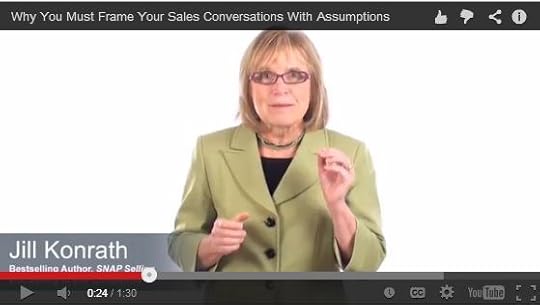






Why You Must Frame Your Sales Conversations With Assumptions
From the first day I started selling, I was told that I should never, ever assume – that it would only lead to failure. Instead, I was supposed to be consultative, learning about a prospect's situation before I made any definitive recommendations or pronouncements.
Well, today things are different. To be effective in today's business environment, you need to assume. Why? Because it makes you sound like you know what's going on. Let me show you what I mean.
Non-Assumptive Approach
If you were non-assumptive, your first sales conversation with a prospect might go like this:
"Hi Pat. I'm Jill Konrath with Leapfrog Strategies. We specialize in state of the art solutions for companies like yours. I'd like to meet with you to find about how you're handling your needs in this area and show you how we can help."
A crazy-busy prospect wouldn't waste one second with you.
Assumptive Approach
But if you said this, the reaction you get would be fundamentally different:
"Pat. Jill Konrath here. I know much the economy is having an impact on manufacturing companies like yours. We've found that way too many organizations are paying too much on their software licenses. We've been able to trim their expenses by up to 22.7% in the first year. Let's set up a time to talk about how we can impact your company."
See the difference? When you assume your prospects have similar issues and concerns, you can frame your sales conversations to showcase your expertise. So start assuming today! 






March 15, 2014
Funny Simulation: The Truth About Conference Calls
If you're selling, you've been on conference calls. And honestly, they can be a bit disruptive. That's why I thought you'd enjoy this video that provides a great simulation on what actually occurs.
QUESTION: What are some best practices that will minimize or eliminate these kind of problems?
P.S. Many thanks to Bill Craig from GSI, Inc. for sharing this video with me.
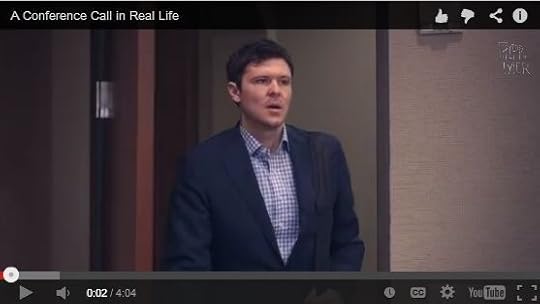






March 11, 2014
[Video] Dealing with Crazy-Busy Prospects
How does being "crazy busy" impact selling? It affects your prospects in a huge way.
First of all, your prospects put up barriers to access. They're protecting their time at all costs so it's much harder to set up an initial meetings. But it goes beyond that.
Your prospect today can't handle much complexity, so you can easily throw them into overwhelm by giving them too much information at one time. If it's hard for them to decipher the business value of your product or service, they'll just forget about it.
Speaking of forgetting – crazy-busy people are forgetful. They forget that they were going to get back to you. They forget that they were going to organize a meeting. That's what being frazzled does to you.
And, crazy-busy people subscribe to the philosophy that "If it's not broken, why fix it." That means you'll have to really work hard to ensure they understand how much better – from a business value standpoint – that things will be if they work with your company.
Finally, crazy-busy prospects think that you and your competitors are near clones of each other. To them, any differences are minutia and any advantages are temporary. This makes it a whole lot more challenging to differentiate yourself and keep out of price battles.
But it can be done – if you focus on the four SNAP Rules throughout the sales process.
4 SNAP Rules
Keep it Simple
Be Invaluable
Always align with their business objectives
Raise priorities
Think about it. This is what works today.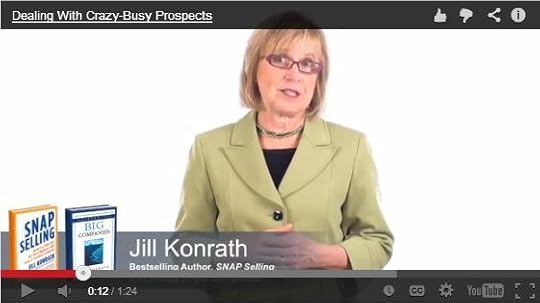






March 6, 2014
80+ Leading Business Experts Share Their Top Sales Secrets

Join me at the 2014 Sales Acceleration Summit. The brightest minds in sales and marketing will share their secrets in a rapid-fire series of online presentations you won't want to miss.
The first summit, held in June 2013, attracted more than 16,000 sales leaders from all over the world. The upcoming event promises to be bigger, better and faster.
In all, more than 80 sales experts, authors and business leaders will serve up their secrets in 15 minutes or less on March 13. The opening and closing keynotes will last 30 minutes each.
Confirmed speakers include:
Matt Dixon, author of The Challenger Sale
Grant Cardone, author of Sell or be Sold
Jeffrey Gitomer, author of Little Red Book of Selling
Jill Konrath, author of SNAP Selling & Agile Selling
Keith Ferrazzi, author of Never Eat Alone
Anneke Seley, author of Sales 2.0
Brent Holloway,Sr. Manager, Global Inside Sales, Hewlett-Packard
Mike Bosworth, author of Solution Selling
Josh James, CEO and founder of Domo
David Elkington, CEO and founder of InsideSales.com
Jill Rowley, Social Selling & Social Business Evangelism & Enablement, Oracle
Steve Young, NFL Hall of Fame Inductee
It’s shaping up to be the biggest online event of the year for the sales industry, and you can attend all of the value-packed sessions at no cost.
Register for the free event: http://bit.ly/JillKonrathSAS-14
Attendees entering the virtual expo center will be given the option to watch on-demand sessions in which the attendees can learn about new ways to increase revenue, strategic and tactical sales expertise, and new sales technologies. Information will be presented by executives of rapidly growing sales teams and best-selling authors.
More than 20,000 C-level executives and sales leaders are expected to attend.
Follow #salessummit on Twitter and Google+ to join in on the live conversation.






March 4, 2014
Avoid This Killer Sales Strategy at All Costs
This is the most important blog post I've ever written. It's about what happened exactly one year ago today. Please read it and share it with others.
Last week a friend told me about a recent fender bender. While driving, he'd been dictating an email on his cell phone. He wanted to get a few extra things done before he got to the office.
We all do things like that. Multitasking is a way of life. It's our strategy to keep up with our whirlwind of a job. In the car, we'll make calls, catch up on messages and text people when we’re running late.
That’s exactly what Carla Brennan was doing on the morning of March 4, 2013 – the day her life collided with mine (and others). Literally.
Here's what happened. My husband, Fred, left our house about 9 AM. Fifteen minutes later he called. His voice was weak, shaken. “I’ve been in an accident. I think people were hurt -- badly.” After assuring me he was okay, he told me where he was.
I rushed to the scene, ½ mile from my home. It was cordoned off. A helicopter was there. Ambulances, police and fire fighters were everywhere. Someone escorted me to my husband, very carefully maneuvering me around the accident scene to get to his car about a block up the road.

When I got there, he was still in the Suburu, behind the wheel, bloody and covered with glass. “I think I hit some pedestrians,” he said in a daze. “Do you know what happened to them?”
I didn’t, but it was clear he needed medical attention.The EMTs took over and I followed them to the emergency ward. I was grateful he was alive.
So what actually did happen that morning?
When Fred turned onto the main street by our place, he noticed a man and woman out for a walk. To avoid crowding them, he moved into the inside lane. Not another car was in sight. Moments later, he glanced in the rear view mirror and saw a car bearing down on him at an incredible speed.
Instantly it slammed into him, propelling his car like an out-of-control projectile in the direction of the two pedestrians. As he desperately tried to avoid them, he saw the man push his wife out of the way in an attempt to save her life. After hitting them, his car careened into the bridge barriers, ricocheted back onto the road and finally came to a stop half a block away.
In the blink of an eye, everything changed.
Ms. Brennan, the driver of the car that hit my husband, was late for work that morning. She was speeding. And then she got a text from her boss. “Where are you?” it said. She replied … and before she finished she ran into my husband’s car.
The truth is, she never even saw him. She was too wrapped up in her message, trying to text her boss that she was on the way. It was a deadly mistake.
 Distracted driving killed Dave Henson.
Distracted driving killed Dave Henson.He was 57 years old, a marathoner, biker, golfer, loving husband, father of 3, grandfather of 12 and all-round good guy. His wife, Leslee was severely injured and transported via helicopter to a major trauma center.
Flash forward a year.
Since the accident, Leslee has made a miraculous recovery, despite having over 5000 stitches, a broken neck, a broken back and multiple other injuries. She misses her husband terribly, as do her children and grandchildren. Such a tragedy. (Check out her video below.)
My husband still struggles with what happened. Even though intellectually he knows that it wasn’t his fault, he still feels a sense of responsibility.
Ms. Brennan has been charged with 2nd degree criminal vehicular homicide involving a handheld wireless communication device while driving. Her trial is coming up soon. She will likely spend time in jail. And, she'll have to live with the fact that her actions killed a good man.
The eye-opening facts on distracted driving.
The truth is more than 80% of drivers admit to blatantly hazardous behavior while driving. I used to be one of them. The accident changed me. So did these eye-opening statistics*.
Distracted driving is a factor in 1 out of 4 crashes nationally.
Texting while driving makes you 23 times more likely to be in a car crash.
When drivers read/send text messages, their reaction time is doubled.
4.6 seconds is the average time your eyes are off the road when texting. If you're going 55 mph, you will travel the length of a football field during that time.
Drivers on cell phones are more impaired than drivers with a .08 blood alcohol level (legally drunk).
Using a cell phone while driving makes you 4x more likely to get into a crash serious enough to injure yourself.
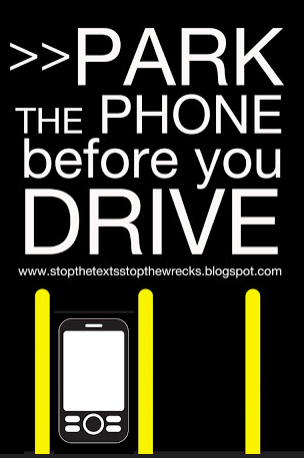
Don't be driven to distraction.
Clearly this is a problem of epidemic proportions. While we sometimes get caught up in the urgency of our work, the truth is ... it can wait. Seriously. It's not a good sales strategy. In fact, it's a killer.
Please, please, don't text while driving. Pull over to take any calls. And, if you're the passenger in the car, make sure the driver follows these rules too.
Doing so could save your life. And, it could save the lives of your friends, family, children, colleagues and total strangers. That's what matters.
____________
A Texting Tragedy: To learn more, check out this video with Leslee and my husband. And, please share it with anyone who you think needs to see it.
Join the Henson family's Stop the Texts, Stop the Wrecks initiative. Take the pledge and don't drive distracted.
*Statistics from Distraction.gov, USA Today and other sources.






Jill Konrath's Blog
- Jill Konrath's profile
- 28 followers



